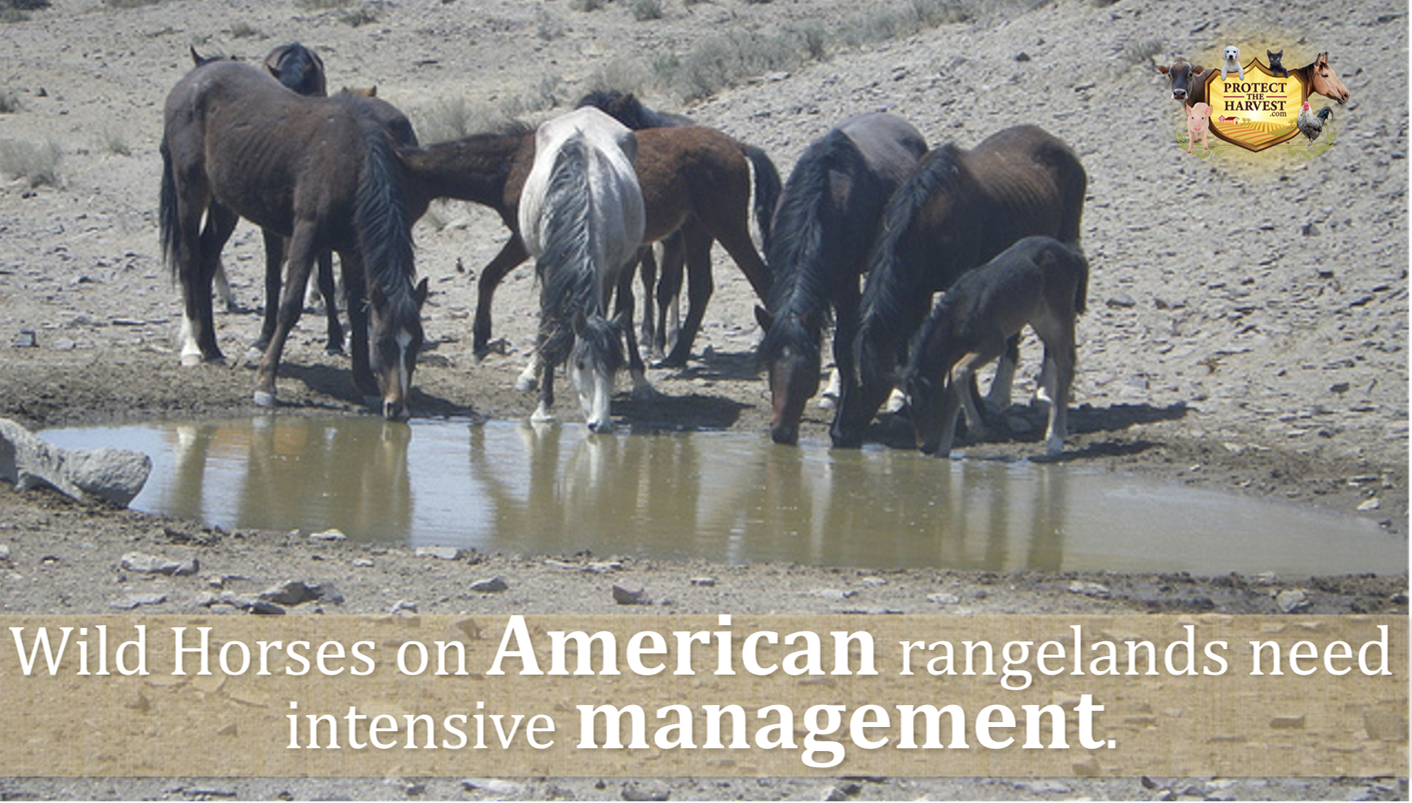
There is an animal welfare crisis occurring on American rangelands that the public needs to know about. This crisis involves rangeland horses and native wildlife. It also involves the rangeland ecosystem.
Due to unchecked populations of horses, lands that were once covered in vegetation have been turned into barren plains of dirt and dust. Due to drought and damage from high numbers of horses, springs and other water sources are drying up or destroyed. Native animals, once dependent on these lands and water sources, are dead or dying out. In addition to the animal welfare crisis, American ranchers are being pushed off their permitted land where they own both grazing and water rights. As a result, the world is losing important food producers.
In years past, the situation was not always this dire. There is a long history of horses in America, their involvement with individuals, and their management. Only in the past few decades has a crisis been building. It is important for Americans to learn about the animal welfare crisis happening on the rangelands in the West, the impact of feral horses, and our responsibility to manage the horse population to mitigate their impact.
The following information will discuss the problem and examine the causes:
The rangeland horses of today are not a native species. They were originally introduced to North America by European explorers and then were adapted into the culture of some of the indigenous tribes. As a part of tribal culture, the horse populations were managed. Rangeland horses were used for transportation, food, clothing, shelter and for warfare. Horse ownership was also a symbol of social status.
Later, as the West was settled, farmers and ranchers turned their horses out onto the rangelands to mingle and breed with the horses in the area. These resulting herds of horses were also managed and used for transportation, farming, ranching, and as food or remounts for the Cavalry.
Contrary to what many non-governmental organizations (NGO’s) are leading people to believe, not all government land is used solely for preservation. Our public lands are intended to be multi-use, including habitat conservation, recreation, natural and cultural preservation, health and safety, and commercial use. When determining the use of public lands, the government realized that a growing population would also need a supply of food and other resources. Therefore, the government sold grazing permits to ranchers in order to provide food resources to a hungry and growing nation.
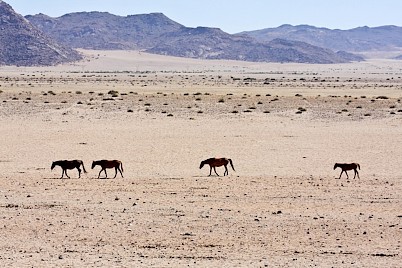
Many Americans are unfamiliar with the high desert ecosystem of the western rangelands. This is most obvious from reading comments where they claim that horses can easily acquire enough feed on one to five acres and therefore, the herd management areas can handle hundreds of thousands of horses. This might be the case in areas where there is significant rainfall and grasslands, however, it is not the case where the majority of rangeland horses are found. For example, in Oklahoma, the average precipitation is 36.5 inches per year and therefore the land can sustain a large number of livestock. However, on most of the high desert western rangelands where the herd management areas exist, the average rainfall can range between 4-6 inches per year. This is a stark contrast to the rainfall amounts in most other areas of the country. It takes significant rainfall to produce grasses for grazing animals. On the high deserts of the west, it can take upwards of one thousand acres to sustain just one horse on a yearly basis.
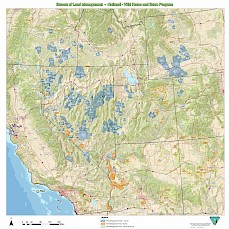
A myth surrounding horses on American rangelands is human encroachment. The herd management areas comprise of 33,000,000 million acres of land, or 50,000 square miles. Most, but not all, of the HMAs comprise of rocky, rough, high desert terrain located in remote areas hundreds of miles away from major metropolitan hubs. The threat to rangeland horses is not human encroachment, rather, it is year on year drought, the unchecked horse population increase, as well as lack of enough feed and water resources.
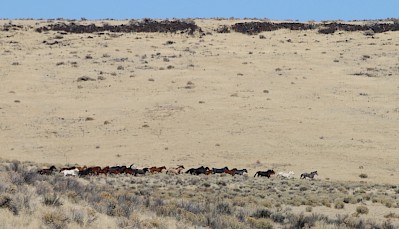
In 1971, with the passing of the Wild Horse and Burro Act, the horses became the protected property of the government. This action turned the responsibility of managing the horses over to the Bureau of Land Management (BLM). When Congress signed the Wild Horse and Burro Act, provisions were written to allow for humane management options in order to keep the numbers of horses at appropriate management levels (AML) based on what the ecosystem could support. In the early years, this worked well. The BLM was able to maintain an appropriate population of horses by following the management practices, as mandated by Congress.
For more information about the Wild Horse and Burro Act of 1971: https://www.blm.gov/or/regulations/files/whbact_1971.pdf
Since the wild horses of today were introduced to the land, and are not native, they are considered an invasive species on the rangelands. They have no natural predators. Researchers have determined that the horses are able to double their numbers within a 4-5-year time period. Therefore, without natural predators and proper management, the size of their herds can and have approached unsustainable numbers very quickly.
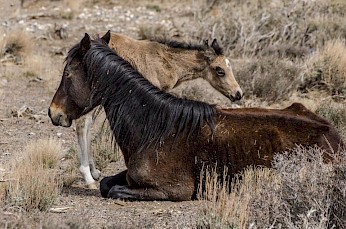
In August of 2015, Bureau of Land Management (BLM) officials gathered over 200 wild horses at Cold Creek in Southern Nevada due to extreme drought and lack of food (Wheeler Pass HMA). According to an article in the New York Times: “ A spokeswoman said horses were traveling 10 miles or more to find water and food and had resorted to eating desert shrub species and Joshua tree bark, which has little or no nutritional value. Twenty-eight were killed because of their poor or extremely emaciated body condition.”
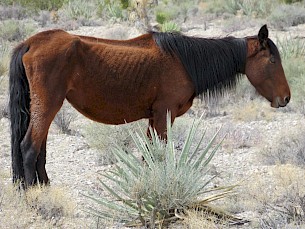
In following years, the BLM has had to repeat emergency gathers in the Cold Creek and other Herd Management Areas. Emergency gathers are conducted to prevent horses from starving due to extreme drought, overpopulation, lack of feed, and severe damage to the rangelands ecosystems, including water sources.
Unfortunately, in recent years, the Bureau of Land Management has been unable to manage the horse population numbers as mandated by Congress. This is due to the fact that nongovernmental organizations (NGO’s) have created roadblocks to management at every turn. The result has been catastrophic for the horses, the native wildlife and the rangelands ecosystem. The 2018 census shows that there are 80,000 horses on the rangelands, three times the appropriate management level of 27,000 for a healthy ecosystem.
What many people do not realize is that grazing allotments are seasonal and for specific numbers of livestock. The amount of feed available determines the numbers of livestock ranchers are allowed to turn out each season. Currently, due to prolonged drought and lack of feed, there are some ranchers that have not been able to use their grazing allotments for years.
In many herd management areas, the only source of water comes from wells and springs developed by the ranchers that own the grazing allotments and the water rights. When ranchers are unable to turn out their own livestock, they are not out on the rangelands maintaining the springs or pumping water which is utilized by the rancher’s livestock, rangeland horses and native wildlife.
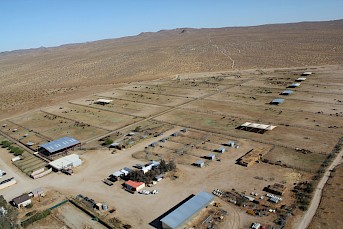
In order to prevent tens of thousands of horses from dying an inhumane death on the rangelands, the BLM has been forced to gather horses and keep them in long-term holding facilities or boarding in pastures belonging to private landowners. As of 2018, over 50,000 horses are in long-term holding, costing American taxpayers $60,000 per day/$50,000,000 per year to feed. The majority of those horses are not adoptable and will live out the rest of their lives in the holding pens.
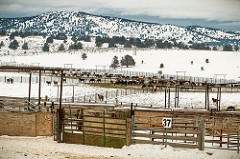
There are a number of adoption programs available for rangeland horses. The BLM has invested considerable time and effort into helping encourage adoptions of rangelands horses. They run a special website that showcases available horses and conduct adoption days across the country. The Mustang Heritage Foundation created the Trainer Incentive Program (TIP) which pays trainers to gentle rangeland horses in preparation for adoption. There are also a number of mustang groups across the country that offer Mustang Makeover competitions. In spite of all of these efforts, the average number of adoptions each year only ranges around 2,700. While that number seems impressive, it is not nearly enough to help manage the population growth, even if it were doubled. At the current rate of 2,700 per year, as it stands in 2018, it would take 18 years to clear long-term holding. That 18-year number is not even accounting for continued population growth.
For information about the TIP Program: https://mustangheritagefoundation.org/tip/
Link to BLM Adoption Website: https://wildhorsesonline.blm.gov/Animals
Link to information about BLM Herd Management Areas: https://www.blm.gov/programs/wild-horse-and-burro/herd-management/herd-management-areas
BLM Statistics: https://www.blm.gov/programs/wild-horse-and-burro/about-the-program/program-data
Some groups advocate for the use of PZP as a form of population control. PZP is an insecticide that causes infertility in mares. Over a twenty year period, there have been many attempts to control herd populations using this method, with little success. This method has been proven ineffective, costly, and unsafe when administered.
Its use is highly problematic for a number of reasons:
Many of the non-governmental organizations that have thrown up roadblocks to management are deeply tied to radical animal rights groups. Therefore, these organizations are not true advocacy groups, but animal rights groups that focus on rangeland horses as their main target. They value the “freedom” of the horses above all else, including their health and well-being. In short, through their actions, these so-called advocacy groups have created a horrible animal welfare crisis.
Wild Horse Education (WHE) is one such group. It is led by a woman named Laura Leigh, who has been especially problematic. In several areas where there is an over-population of rangeland horses, Wild Horse Education has waged legal battles against the BLM to keep horses from being removed from public ranges. They have filed numerous lawsuits in spite of the fact that the overpopulation of the horses is destroying the rangelands ecosystem for both the horses and native wildlife. The American Wild Horse Campaign is another so-called advocacy group that has filed lawsuit after lawsuit to impede the BLM’s management efforts. Link to information about the American Wild Horse Campaign:
Wild Horse Education, American Wild Horse Campaign and similar animal rights groups are using the plight of horses on American rangelands for their own fundraising benefits. They show images of rangeland horses with pleas to “donate to save the Mustangs,” when little if any, money they raise actually goes to providing care for rangeland horses or to control the population of the horses in any significant way.
In places like the Owyhee Complex, Wild Horse Education has gone to great lengths to impede the BLM’s management efforts. This group took advantage of a horse named “Sarge,” who was in rapid decline, in order to raise funds. In spite of raising money on Sarge’s behalf, this group allowed Sarge, and horses like him, to continue suffering.
The hypocrisy of the actions of the groups Wild Horse Education and American Wild Horse Campaign as well as another group called The Cloud Foundation are unprecedented. Horses are starving to death in the areas where these groups want them to remain. While they throw up roadblocks to management, they also sue the BLM for not properly managing the horses and also for making attempts to manage the horses. It truly is a hypocritic and dysfunctional situation. The only winners are these NGO’s who profit from their “sue and settle” schemes, meanwhile the horses lose.
Some concerned citizens often ask about trucking feed and water out to horses in Herd Management Areas (HMA’s) where horses are at risk. Sadly, the hands of both ranchers and citizens are often tied – there are many laws in place to stop individuals from feeding or watering wild horses. Additionally, the herd management areas comprise of hundreds of thousands of acres of rough terrain. Trucking water or dropping feed is often not feasible. Others often suggest spreading grass seed over the herd management areas, this is also not feasible and even if it were, rainfall is needed in order for seed to germinate and to continue to grow.
For a number of years, the BLM has proposed a study to evaluate the standing surgical spay for population control. The procedure is done in a specially designed chute following veterinary surgical protocol including anesthesia, pain management, surgical sterilization, and long-lasting antibiotics. In total, it takes about 15 minutes, with the procedure itself taking less time than the surgical prep. After the spay procedure, mares can be returned to the wild, possessing all her mare behaviors, as if she was in foal. The procedure is the same approach used to spay tens of thousands of heifers each year that are not intended for breeding. The spaying procedure costs a little more than HALF of ONE dose of PZP and is only performed once in a mare’s lifetime, meaning there would be no need for repeated gathering off the range.
Unfortunately, animal rights groups have thrown up roadblocks by filing lawsuits to prevent the BLM from going forward with their proposed studies.
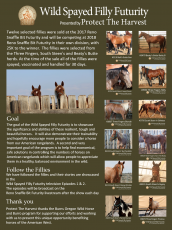
In response, Protect The Harvest has stepped in and created the Wild Spayed Filly Futurity, a program that demonstrates that the standing surgical spay is a viable, humane option for population control and also to showcase the horses in hopes to help increase adoptions.
Learn More about the Wild Spayed Filly Futurity
The group, Wild Horse Education and their leader, Laura Leigh, advocate for the typical animal rights “hands-off” approach, claiming that the overpopulation crisis will correct itself. If Laura Leigh and other so-called advocates had their way, all public lands would be dedicated solely to rangeland horses. Laura Leigh has even gone so far as to justify the condition of the horses by claiming their poor health is expected because they are out in the wild. This means they are advocating for allowing tens of thousands of horses to die a slow and agonizing death from starvation. Allowing an animal to die from starvation and dehydration is simply inhumane.
The public is often asked the question, “Should we let thousands of horses starve instead of appropriately managing the land?” Their answer is always the same: “no.” Whatever form of ethical reasoning a person uses, they do not want to see the animals starve. The exception is the animal rights ideologues who believe that the horses should manage themselves. In addition to holding fast to the ideology that animals should be free from human intervention, horses in crisis provide excellent fundraising opportunities for animal rights groups.
With the numbers of rangeland horses continuing to climb and diminishing options in the face of complete destruction of rangeland ecosystems, the BLM is now confronted with some hard decisions. Unfortunately, increasing adoptions and fertility control programs are no longer sufficient to address the crisis as a whole. Even if annual adoption rates were increased tenfold, it would not be enough to offset the growing population numbers.
One logical solution is for the USDA to allocate budgetary funds for horse processing inspectors. This way, the herds can be reduced to appropriate management levels and the excess horses can be humanely culled and utilized. This is an option that would provide immediate relief to the rangelands ecosystem. It would also provide immediate relief to the remaining horses and wildlife on the rangelands.
We believe that the horse is a symbol of the American West. Rangeland horses are an important part of our heritage and culture. It is a travesty that they are now in crisis and have become the victims of the ideology of the animal rights agenda. The horses deserve better. The American public has it in their power to step up on behalf of the horses and support the BLM’s efforts to properly and humanely manage their populations as well as protect the future of the horses, the rangelands ecosystems, native wildlife, and our American ranchers.
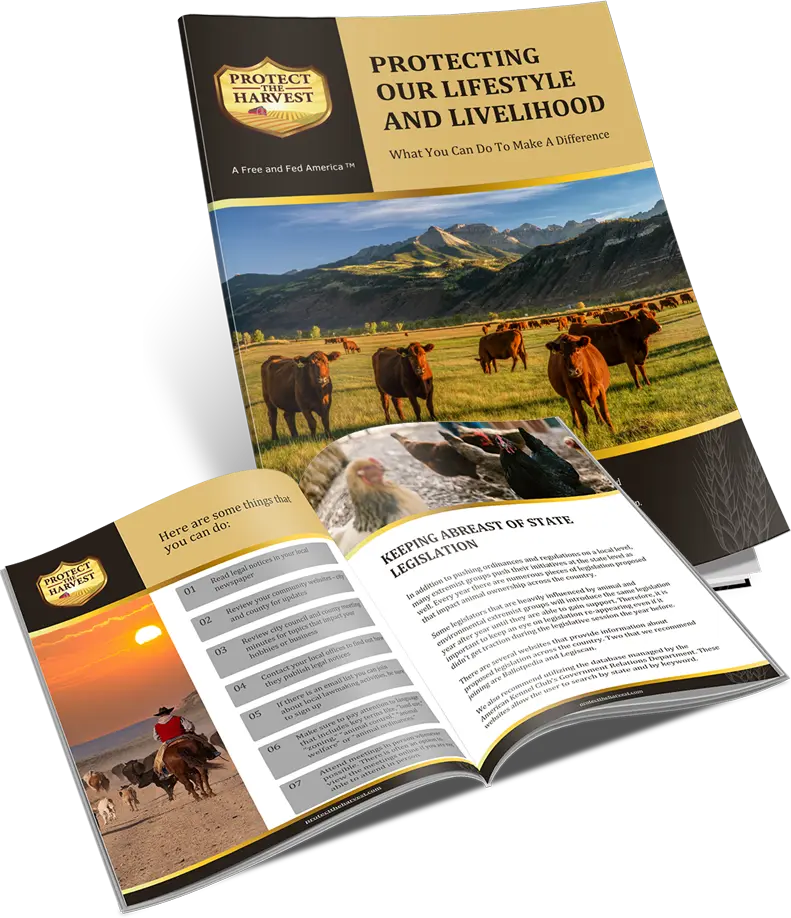
© 2023 Protect The Harvest. All Rights Reserved
StoryBrand Website design by Results and Co.